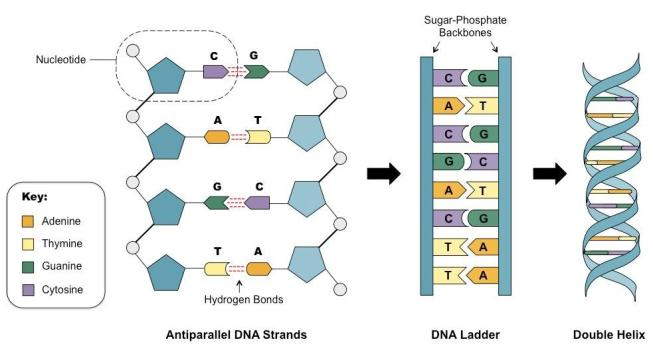
What is the meaning of the anti – parallel strands of a DNA molecule?
Answer
410.4k+ views
Hint: The term ‘anti – parallel’ means strands that are extended in opposite directions but parallel in nature. According to the Watson & Crick Model, DNA which is present in the chromosomes of the cell has a double helix structure.
Complete answer:
DNA i.e DeoxyRibonucleic Acid is the genetic material which passes from the parent to the offspring & carries morphological as well as genetic characteristics of the organisms. The double helix structure of a DNA is composed of two polynucleotide chains forming a ladder-like structure. The polynucleotide chains are anti – parallel to each other and the nitrogen bases are arranged through each chain.
The anti – parallel strands of a DNA molecule mean the phosphate group present in the start of two DNA strands are in opposite poles. The two strands are twisted to each other. One strand consists of the 3’ – 5’ linkage and the other strand has the opposite 5’ – 3’ linkage. [the 5’ – 3’ indicates 5 prime to 3 prime which is the number of carbons present in the DNA backbone]. The 5’ and 3’ consist of phosphate and hydroxyl groups respectively.
This opposite structural direction of the DNA molecules double helix model denotes the anti – parallel strands of a DNA molecule.
Note:
The double helix structure of DNA was invented by Watson & Crick thus known as the Watson-Crick model. The twisted anti – parallel strands have opposite linkage & contain nitrogen bases and pentose sugar. The purine groups are – Adenine & Guanine. The pyrimidine groups are – Thymine & Cytosine.

Complete answer:
DNA i.e DeoxyRibonucleic Acid is the genetic material which passes from the parent to the offspring & carries morphological as well as genetic characteristics of the organisms. The double helix structure of a DNA is composed of two polynucleotide chains forming a ladder-like structure. The polynucleotide chains are anti – parallel to each other and the nitrogen bases are arranged through each chain.
The anti – parallel strands of a DNA molecule mean the phosphate group present in the start of two DNA strands are in opposite poles. The two strands are twisted to each other. One strand consists of the 3’ – 5’ linkage and the other strand has the opposite 5’ – 3’ linkage. [the 5’ – 3’ indicates 5 prime to 3 prime which is the number of carbons present in the DNA backbone]. The 5’ and 3’ consist of phosphate and hydroxyl groups respectively.
This opposite structural direction of the DNA molecules double helix model denotes the anti – parallel strands of a DNA molecule.
Note:
The double helix structure of DNA was invented by Watson & Crick thus known as the Watson-Crick model. The twisted anti – parallel strands have opposite linkage & contain nitrogen bases and pentose sugar. The purine groups are – Adenine & Guanine. The pyrimidine groups are – Thymine & Cytosine.

Recently Updated Pages
Express the following as a fraction and simplify a class 7 maths CBSE

The length and width of a rectangle are in ratio of class 7 maths CBSE

The ratio of the income to the expenditure of a family class 7 maths CBSE

How do you write 025 million in scientific notatio class 7 maths CBSE

How do you convert 295 meters per second to kilometers class 7 maths CBSE

Write the following in Roman numerals 25819 class 7 maths CBSE

Trending doubts
Give 10 examples of unisexual and bisexual flowers

Draw a labelled sketch of the human eye class 12 physics CBSE

Franz thinks Will they make them sing in German even class 12 english CBSE

Draw a diagram of a flower and name the parts class 12 biology ICSE

What is the Full Form of PVC, PET, HDPE, LDPE, PP and PS ?

The speed of light will be minimum while passing through class 12 physics CBSE




